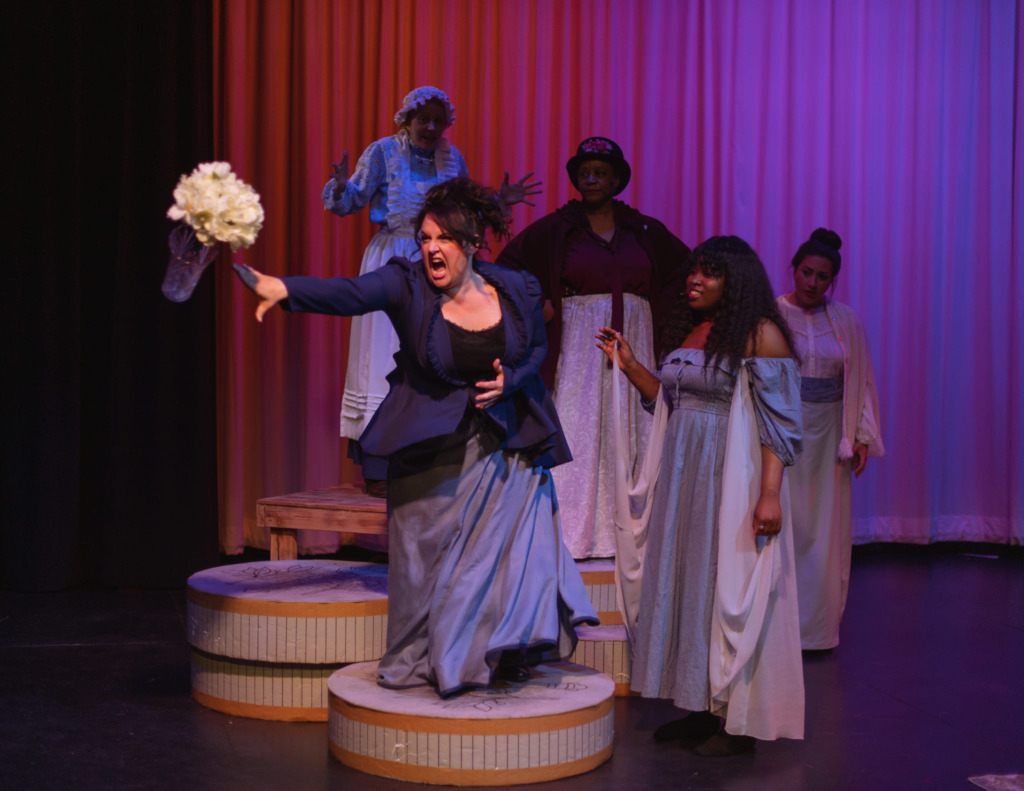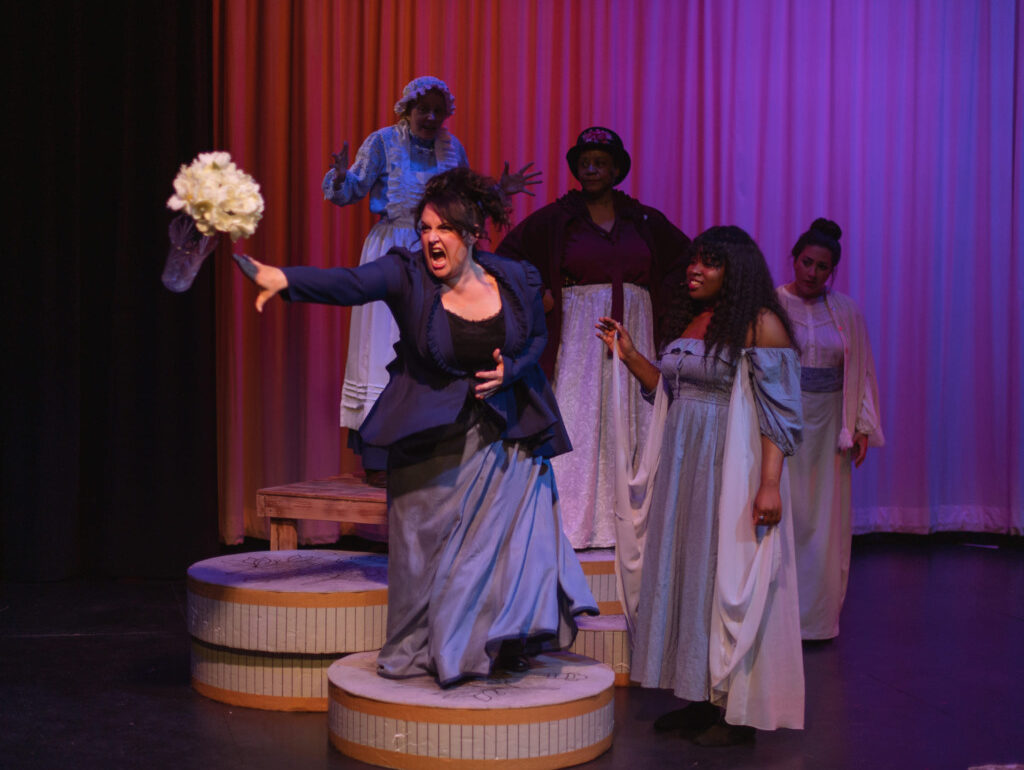Resolved to never belong to anyone but herself, Edna Pontellier controlled her own destiny.
But I’m getting ahead of myself.
Picture it. A balmy, breezy, almost tropical evening on Grand Isle. Louisiana Gulf. Cottages. 1890’s. Summertime. Can you feel the sea breeze blowing in? Smell the scent of the water? Can you hear the French Creole dialect running thick like Cajun gumbo through the words that get spoken? You’ll picture it a whole lot better if you slip on over to Endangered Species Theatre Project this April to experience their extraordinary production of Rebecca Chace’s The Awakening. Adapted from the novel by Kate Chopin, Chace’s work has a similar feel to that of playwright Kate Hamill (Pride & Prejudice; Sense & Sensibility), where it has an ensemble verve that evolves around a central person whose story it is. The ensemble move as both narrators and active characters, transitioning flawlessly between the two devices of storytelling and active-living. Directed by Christine Mosere, with Musical by Marci Shegogue & Gillian Shelly, this wildly vivacious, almost fanciful story of self-discovery alights upon the stage for a wondrous evening of theatrical endeavors.

It’s a deceptively simple set. Physically just two platforms painted to look like long-decks. Some chairs, a few raiser-rounders for elevation purpose, and silhouetted frames that almost look like oversized standing-fan-dividers only without the screen. And a scrim across the back to catch all of the emotional coloring of Lindsey McCormick’s lighting design. The set, designed by Deanna Kinzie, lets this fine ensemble of a dozen performers tell the story without flashy gimmicks or fancy trappings. Kinzie is also the show’s Costume Designer and the outfits give you just enough hint of time and place to ignite the imagination. Again substance over flash, letting these talented performers and the story being told, speak for itself.
Having live music (written by Myra Platt and performed by Marci Shegogue on keyboard, Jimi Cupino on guitar, and Stephen Kime on guitar) is a unique component to what is otherwise a straight-forward play. Not only because the delightful underscoring of the show— particularly at the beginning with the mysteriously haunting but intriguing glockenspiel/xylophone sounds (effects created by way of Shegogue’s brilliance on keys) that pull you right into the enigma that is this narrative— carries along with the plot like a current drifting along in the ocean, but because there is singing. Sometimes just one performer, sometimes the entire ensemble. Platt’s music, both lyrical and instrumental, are an intrinsic component to the mystique of this play, adding a cerebral layer of fascination to the overall experience, much of which escalates, or rather— ebbs and flows— with the emotions of the story as the unfurl.
Choreographer Ray C. Shaw puts forth an impressive effort even if there isn’t a boatload of traditional dance routines. There is definitely some noteworthy tango moments between the Edna character and the Alcée character, which serve as an actualization of the pair’s erotic chemistry. What is both appealing and intriguing about Shaw’s work in the collective ‘blockography’ and movement of the ensemble. This is most praiseworthy when they are, as one, the ocean. Or when they’re swimming about as people in the ocean. Both happen in this performance; both are distinct from one another and both are wild to behold. Intimacy Director Julie Herber deserves a nod of praise as well; often times there are moments of intense intimacy that develop even when the characters do not touch or do something as innocuous as touching hands. Such an intensity of that caliber could not be achieved so thoroughly in those moments without a safe and focused workspace for the actors involved in the production. The emotions, particularly the intimate ones, run high throughout this performance and are often thickly palpable, particularly to the audience.
Director Christine Mosere has brought together a wondrous ensemble, allowing each to find their niche, with several members playing more than one character. The pacing is as crisp as the ocean water is refreshing, and the ability with which these performers slide in and out of their narrative voices— one moment like third-person, omniscient storytellers unwinding a yarn for your pleasure, the next fully engaged as their character in whatever scene their narrative selves have just described— is sheer theatrical brilliance and magic. There is never a dull moment on the stage; Mosere and the cast keep your attention to the last, which is a breathtaking, astonishing, and shockingly peaceful denouement.
One of the most notable performers among the ensemble is Sasha Carrera in her role as Mademoiselle Reisz. With the epitome of a perpetually stooped hunch, a stiffened yet prestigious gate, and the movements that betray her character’s wizened years, Carrera has this beautiful grace and dignity about her when addressing the physicality of the character. Her accent is as equally divine to hear as is her mannerisms and movements are to watch. Very southern French Creole, something polished with Bayou roots and a hint of locale to it whenever she speaks. Perfectly understandable and balanced with the perfect temperament for some of her more waspish comments. Remarkable!
You get an effervescence that burbles and splashes not unlike a little wave just cresting against the shore when it comes to Olivia Ercolano’s Adele Ratignole. Naïve in an almost childlike manner, though only in the vein of her exuberance, there is a simplicity to this ‘Mother Woman’ character. She lives, breathes, exists, and is solely for her children. While the lack of characterization for Adele Ratignole is Rebecca Chace’s intention in her writing, Ercolano finds subtle moments to give Adele hints at more depth. Watch her eyes and face closely when she and Edna are discussing living for their children; the flustered state with which she expresses her inability to understand what it is Edna is talking about is so much more than a lack of understanding; it’s a pristine portrayal of forced-ignorance for the sake of achieving bliss.
You get glorious narrative and singing voices from the Female and Male voice of the Sea (Victoria Causey and Ray C Shaw, respectively.) They often appear in the periphery of the scene, alluding to the fact that they are likely constructs of Edna’s mind. (If you read the conveniently placed and carefully cultivated character map, which can be found on your seat upon entering the theatre, you’ll note the specific question of ‘All in Edna’s Head?’) Shaw also doubles up as Dr. Mandelet, who delivers what is arguably one of the funniest lines of the show (a direct quote from Kate Chopin’s novel) — “…when ordinary fellows like you and me attempt to cope with {women’s} idiosyncrasies the result is bungling.”
With a straw-cream suit that makes him initially appear like a sun-warmed-vacationing version of Colonel Sanders, Sasha Olinick appears on the scene as Leonce Pontellier with an undeniable gusto and vigorous aplomb. Hearty of spirit, hefty of merriment, and generally pleasing to listen to, Olinick plays a somewhat vexing character as you feel both frustrated by his behavior and sympathy for the fact that his wife is the way she is. For once, it isn’t brutish, boorish, untenable behaviors that have pushed Edna to where she is, it’s just her own free will, yearning and need, and Leonce Pontellier’s utter incapability as understanding it as anything other than ‘mentally unstable’ (hence the frustrating part) that put both characters where they are by the end of the show.
Horribly charming, sleekly suave and debonair, Stephen Kime as Alcée Arobin is seduction incarnate. And often he just fixes Edna with a look, a simple phrase, or a fleeting touch. It’s sinful subtly at its finest. Kime moves like the covert Casanova his character portends to be, there is an unyielding progression to each of his steps, his phrases, his physical contact, especially once he starts dancing. And when Kime doubles up as Baudelet, the boatman, he’s quirky with a colorful-locale sort of charm.
Always to be regarded as a feature for an amusing program, Matt Baughman proves that he is so much more than a comedic genius upon the stage in his role as Robert Lebrun. There’s an unexplored world in Robert’s existence, one that Baughman gives us delightful insight into with a teasing retort or a somber reply. The versatility that Baughman displays with this character is astonishing. Lighthearted but never too light. Serious but never gravely so. There is balance and chaos in his portrayal. When Baughman’s Robert sets off on the boat with Edna, the pair are practically punch-drunk on each other’s presence. All innocent, all demure, and all adorable yet ever-so-slightly troubling. It’s a whirlwind exchange to experience and Baughman is bringing it full force.
Gillian Shelly is a tour du force and a force to be reckoned with. Not unlike that raging ocean that could swallow one whole without a second glance or who could easily lap at your feet with a cooling splash upon a hot summer’s day, Shelly is the epitome of versatile. She brings a tenacity and ferocity to the stage the likes of which defy description. Wholly embodying this wildly free spirit that is Edna Pontellier, Shelly confronts the predicament of the character— a free-spirited woman fettered by the confines of mothered, restrained by the chains of marriage, and drowned by the expectations of society. Some of her more exhilarating moments can only be described as brilliant fits of mania; the giddiness and expressiveness tumultuously crashing out over the audience like an unstoppable wave crashing upon the shore. And for every moment Shelly delivers a wild moment at a heightened peak, there are at least two in subdued, introspective stillness for us to ponder and absorb. When she’s in full-voiced duet with Victoria Causey, the Female Voice of the Sea, raging out her emotions and experiences in song— you’re struck in this blindsiding moment of terror and beauty that is both breathtaking and a little frightening. Gillian Shelly is both the eye at the center of the storm and the storm itself, making the unspeakably serene ending so strikingly profound that you’ll weep both tears of remorse and tears of relief.
It’s an impressive performance— and a far better way to absorb the story with this lively bunch. You won’t want to miss The Awakening as adapted by Rebecca Chace, now appearing on stage with Endangered Species Theatre Project.
Running Time: Approximately 2 hours and 15 minutes with one intermission
The Awakening plays with Endangered Species Theatre Project on selected dates through April 21st 2023 at New Spire Arts— 15 W. Patrick Street in the heart of downtown historic Frederick, MD. Tickets are available for purchase at the door, by calling the box office at (301) 305-1405 or by purchasing them in advance online.

